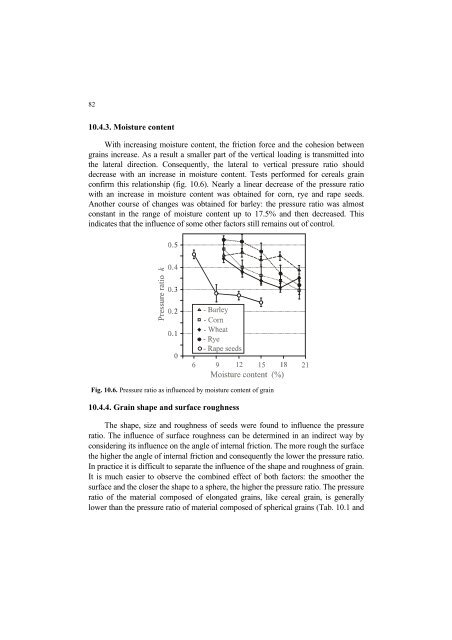Strona 2_redak - Instytut Agrofizyki im. Bohdana DobrzaÅskiego ...
Strona 2_redak - Instytut Agrofizyki im. Bohdana DobrzaÅskiego ...
Strona 2_redak - Instytut Agrofizyki im. Bohdana DobrzaÅskiego ...
You also want an ePaper? Increase the reach of your titles
YUMPU automatically turns print PDFs into web optimized ePapers that Google loves.
82<br />
10.4.3. Moisture content<br />
With increasing moisture content, the friction force and the cohesion between<br />
grains increase. As a result a smaller part of the vertical loading is transmitted into<br />
the lateral direction. Consequently, the lateral to vertical pressure ratio should<br />
decrease with an increase in moisture content. Tests performed for cereals grain<br />
confirm this relationship (fig. 10.6). Nearly a linear decrease of the pressure ratio<br />
with an increase in moisture content was obtained for corn, rye and rape seeds.<br />
Another course of changes was obtained for barley: the pressure ratio was almost<br />
constant in the range of moisture content up to 17.5% and then decreased. This<br />
indicates that the influence of some other factors still remains out of control.<br />
Fig. 10.6. Pressure ratio as influenced by moisture content of grain<br />
10.4.4. Grain shape and surface roughness<br />
The shape, size and roughness of seeds were found to influence the pressure<br />
ratio. The influence of surface roughness can be determined in an indirect way by<br />
considering its influence on the angle of internal friction. The more rough the surface<br />
the higher the angle of internal friction and consequently the lower the pressure ratio.<br />
In practice it is difficult to separate the influence of the shape and roughness of grain.<br />
It is much easier to observe the combined effect of both factors: the smoother the<br />
surface and the closer the shape to a sphere, the higher the pressure ratio. The pressure<br />
ratio of the material composed of elongated grains, like cereal grain, is generally<br />
lower than the pressure ratio of material composed of spherical grains (Tab. 10.1 and
















